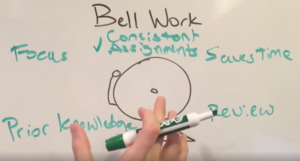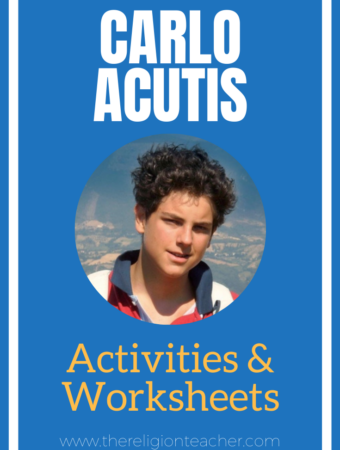
There is nothing like the sound of students working hard on an assignment the minute class has begun. What is that sound? Silence. I loved it. I was able to recover from the class that just ended and prepare for the class that was beginning all while students were learning on their own. In this post I will explain why Bell Work is effective and provide you with some examples of activities you can use in your classes.
What is Bell Work and how do I use it?
Bell Work (also called Bell Ringers) are activities posted on the board or distributed to students as they arrive to class that should be started at or before the time the bell rings (or the time when your catechetical session is scheduled to begin). These activities can be a review of previous lessons, practice of current skills, or introductions to the new lesson of the day. You can communicate Bell Work in the following ways:
- Write the assignments on the whiteboard or chalkboard.
- Type and save the assignment in a Word document, PowerPoint slide, or SMART Board page ahead of time and project it as the students arrive. (This was my personal preference)
- Have a designated place in the classroom for students to pick up the day’s Bell Work (or notes)
Some teachers have students keep a Bell Work journal to complete these daily assignments. You may collect them or briefly check them while they complete their work.
How to Use Bell Work Time Effectively
- Take attendance
- Check homework
- Prepare the other assignments for the day’s lesson
- Pass back homework, quizzes, and other assignments
- Say a silent prayer
- Relax and enjoy the quiet
Here are a few big reasons why you should starting using bell work in class:
Effective Bell Work Activity Examples
• Review Questions – You may use questions from the textbook or create your own about the previous lesson.
• Introductory Questions –Use Bell Work to introduce topics and get students thinking about controversial or interesting ideas related to the lesson of the day.
• Reflective Questions – If you incorporate journaling into your instruction, then the beginning of class is the perfect time to give students the opportunity to journal. Create a question related to the topic of the day, current event, or liturgical year.
• Reading Assignment – In preparation for the day’s lesson you can have students read (or re-read) from the textbook.
• Graphic Organizers – Graphic organizers are ways for students to visually represent the things they have learned. Invite students to use their notes to complete these worksheets.
• KWL Charts – Have students create a KWL chart by folding their paper as if they were sending a letter. Write a topic on the board and have students write everything they know about the topic (under the K column) and everything they want to know (under the W column) and leave the third column blank (what I learned).
• Concept Maps (Mind Maps) – have students write everything they know about a topic (as review or introduction) in concept map form.
• “Entrance Cards” – similar to “Exit Cards,” these formative assessments allow you to view quick responses to questions as a review or an estimation of prior knowledge.
• Photographs and Artwork – Pull up a picture or piece of art from the internet or bring into class a painting to initiate some reflection. You may also accompany the picture with some questions.
• Music – songs can be used to introduce the topic of the day or inspire some reflective journal time.
Download Resources for Bell Work
Want to access a library of worksheets to use for Bell Work? Premium members of The Religion Teacher have access to 100s of worksheets including weekly Gospel reading worksheets to use in class. These activities are perfect resources for Bell Work. In addition, members have access to dozens of class videos and online courses for professional development and spiritual formation.



My students respond well to puzzles. I use puzzlemaker to create wordsearches or crossword to introduce or reinforce vocabulary. also jumbles and cryptograms work well for lines of prayer, scriptures or other quotes/phrases.
Great idea – those types of activites can be challenging and fun at the same time. Thanks!
thanks for sharing activities. they are indeed great help in the classrooms and even in recollections… blessings
February 21, 2010
I have used bellwork for many yrs….although this yr I have gottne a bit lazy..you have reviatlized me!
I have been visiting various blogs for my term papers writing research. I have found your blog to be quite useful. Keep updating your blog with valuable information… Regards
I have used bellringers for many yrs aw well…although I findpuzzles take up too much time…
I do bellwork and I call it Bible Search and Reflect. It is a journal that is graded, 5pts each entry. I have posted on my overhead projector the date, scripture verse(s), title of the verse, and answer the question: How do these verses influence my life?(how can I apply it to my life?). I have choices sometimes but most of the time I choose a Gospel to go through (they usually only get bits and pieces at Mass; it is powerful to listen and talk about Jesus’ message beginning to end) or right now we are going through Sirach (a story of a grandfather is telling his grandson about living a faithful life). Some messages we talk about for quite sometime and some days I go right into our lesson. We label our journal seeds, and I encourage the kids to hold onto them because they are reflecting on valuable information that may be helpful later in their lives. I realize that reading the Bible can be over their head (mine and many other adults, even Scripture scholars)but if Scripture with Tradition is what helps us in our journey to heaven, I feel it is important to do this as daily practice for later in their lives. I always encourage them to read it outside of class and Church.
Great idea, Greg. I really like your effort to intentionally include Scripture in every class. This is something for all teachers to think about, even those teaching about other subjects like Church history, morality, etc.
I do something similar in my Scripture classes. I have a passage reference on the board when the students come into class that relates to what we will be talking about that day in class. On a sheet they keep for the whole week, they summarize the passage on their own. It is a great way to get them reading Scripture on their own! Also, at the bottom of the sheet for the week they write down the Sunday readings and after reading them over the weekend they write the connection between the first reading and Gospel. I have found that students of all faiths appreciate learning more about the Scripture at mass, and my Catholic students enjoy writing connections from the homily.
Bell Work Activities can play a very interesting role in the curriculum of the school.This type of activities can also enhance the interest of the students toward thier studies.
I’m concerned about the students who have parents who always bring their children at the last minute
and they will always feel behind. This, also takes away the time for the students to visit with each other
and come and tell me things!
At the end of class, they are in a hurry to leave because their parents are waiting. When do your students
have a chance to talk to YOU, their Catechist?
Do you have materials for confirmation class?
Guy, we sure do:
https://www.thereligionteacher.com/confirmation-lesson-plan/
https://www.thereligionteacher.com/confirmation-lesson-plan/
https://www.thereligionteacher.com/gifts-of-the-holy-spirit-lesson-plan/
I love the idea about Bell Work activities, especially those pertaining to our faith. Does anyone have some ideas for grade 3 students?
Annie
Hi Jared, I am one of those who have benefitted from your newsletter and other materials you have for Religion teachers. I am grateful to you for helping me come up with activities that could make my religion class more meaningful. This is my first year of teaching religion. I call my bell work, reflection work. I have as my first classroom procedure “Enter the class quietly, take your assigned seat and get to reflection work immediately”. It is some times difficult to get student maintain silence during their reflection work. All the same my kids are not doing badly. I sincerely want to thank you for being charitable enough to share your insight. Thank you so much Jared Dees.
Sr. Evelyn